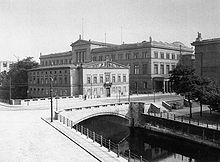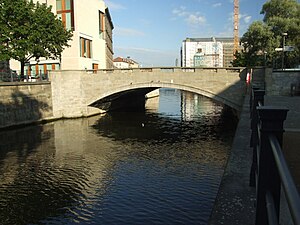Iron bridge
Coordinates: 52 ° 31 '10 " N , 13 ° 23' 51" E
| Iron bridge | ||
|---|---|---|
| Iron bridge | ||
| use | Road traffic | |
| Convicted | Spree Canal , Kupfergraben | |
| place |
Berlin district Berlin-Mitte |
|
| overall length | 20 m | |
| width | 23.00 m, of which 15 m is roadway | |
| start of building | 1914 | |
| completion | 1916 | |
| planner | Walter Koeppen | |
| location | ||
|
|
||
The Iron Bridge in Berlin-Mitte crosses the Kupfergraben , part of the Spree Canal between the Altes Museum and the Neues Museum . It is one of the oldest surviving bridges in Berlin. The single-arched structure connects Bodestrasse (formerly Museumstrasse) with the street Hinter dem Gießhaus .
history


Today's Iron Bridge is the fourth structure at this point. Its name is derived from the second bridge, which was one of the first cast iron arches in Berlin. In 1796 it replaced a wooden bridge from the 17th century. In 1825, the iron bridge had to be replaced by a three-span sandstone bridge after almost thirty years because of its fragility . However, the old name was retained. The sandstone bridge was strengthened due to the increased traffic requirements, especially for the installation of the tracks of the horse tram established in Berlin at the end of the 19th century . The lane width was now 7.20 m, the clearance for the Spree ships was 3.60 m.
With the construction of the Linden Tunnel , the Iron Bridge also had to be rebuilt. As a result of the tunnel construction, the trams could not go left across the street Hinter dem Gießhaus to the linden intersection, but turned right into Dorotheenstrasse, where the tunnel ramp connected. Since the previous bridge was too narrow for the required curve radii, it was rebuilt by the end of 1916. During the construction work, traffic was guided over an auxiliary bridge. The design of the new bridge goes back to the architect Walter Koeppen . It is a faced steel truss arch construction that was founded on wooden piles. It was an ideal match for the museum buildings on the island and met the current traffic requirements. The structure, which was badly damaged in World War II , was makeshift repaired in 1950 and served as part of a rubble railway line .
After the end of the transport of rubble, a basic overhaul was carried out in 1954, during which mainly the steel support structure and the carriageways and walkways were repaired. The trams were given a modified route that no longer crossed the Iron Bridge. In 1966 and 1998 there was further renovation work on the bridge.
In connection with the gradual restoration of all buildings on Museum Island , another true-to-original reconstruction of the Iron Bridge including the artistic bridge railing took place between December 2006 and May 2008. The Iron Bridge is since the mid-1970s under monument protection .
Bridge details
A low stone parapet, each adorned with eight bronze fields, ends on the island side at short two-flight stairs leading to the pleasure garden . At this point, inscriptions provide information about the history of this bridge. The rectangular bronze fields are decorated with ornaments and figures and were also renovated in 2007/2008. The four quarter-round parapet ends carry slender iron four-part ornamental pillars. The supporting structure consists of six steel truss two-hinged arches with spans of 20 m. The self-supporting end walls of the steel construction are clad with Franconian shell limestone. They consist of just one ashlar-deep vaulted strip with rising end faces. The stairs to the pleasure garden with a wall fountain in the middle section also serve as a decorative element of the bridge . On the side of the Neues Museum, a stone spiral staircase leads down to the promenade.
See also
literature
- Institute for Monument Preservation (Ed.): Capital Berlin, I. (= The architectural and art monuments of the GDR .) Henschelverlag, Berlin 1984, p. 191.
- Eckhard Thiemann, Dieter Deszyk, Horstpeter Metzing: Berlin and its bridges. Jaron Verlag, Berlin 2003, ISBN 3-89773-073-1 , p. 22, p. 27, p. 96.
Web links
- Entry in the Berlin State Monument List
- Iron bridge in the district lexicon of the Luisenstädtischer Bildungsverein
- 6 detailed images of the Iron Bridge at Structurae
- Time-lapse film (25 seconds) over a day at the Iron Bridge
Individual evidence
- ↑ Hans-Joachim Pohl: The Lindentunnel . In: Verkehrsgeschichtliche Blätter . Issue 7, 1980, pp. 144 .
- ^ Angela M. Arnold, Gabriele von Griesheim: rubble, railways and districts ; Self-published in Berlin 1999
- ↑ Historical view of the Iron Bridge at the Senate Administration; Tram drives over the bridge; circa 1925
- ^ Uwe Aulich: Iron Bridge reopened . In: Berliner Zeitung , May 16, 2008; Retrieved March 15, 2009
- ↑ Iron Bridge monument.
- ↑ worksheet u. a. to the Iron Bridge ; Retrieved March 15, 2009



